APR-246 combined with 3-deazaneplanocin A, panobinostat or temozolomide reduces clonogenicity and induces apoptosis in glioblastoma cells
- Authors:
- Javier De La Rosa
- Alejandro Urdiciain
- María V. Zelaya
- Idoya Zazpe
- Bárbara Meléndez
- Juan A. Rey
- Miguel A. Idoate
- Javier S. Castresana
-
Affiliations: Department of Biochemistry and Genetics, University of Navarra School of Sciences, 31008 Pamplona, Spain, Department of Pathology, Hospital Complex of Navarra, 31008 Pamplona, Spain, Department of Neurosurgery, Hospital Complex of Navarra, 31008 Pamplona, Spain, Molecular Pathology Research Unit, Virgen de la Salud Hospital, 45005 Toledo, Spain, IdiPaz Research Unit, La Paz University Hospital, 28046 Madrid, Spain, Department of Pathology, University of Navarra Clinic, 31008 Pamplona, Spain - Published online on: January 26, 2021 https://doi.org/10.3892/ijo.2021.5177
- Pages: 312-330
This article is mentioned in:
Abstract
 |
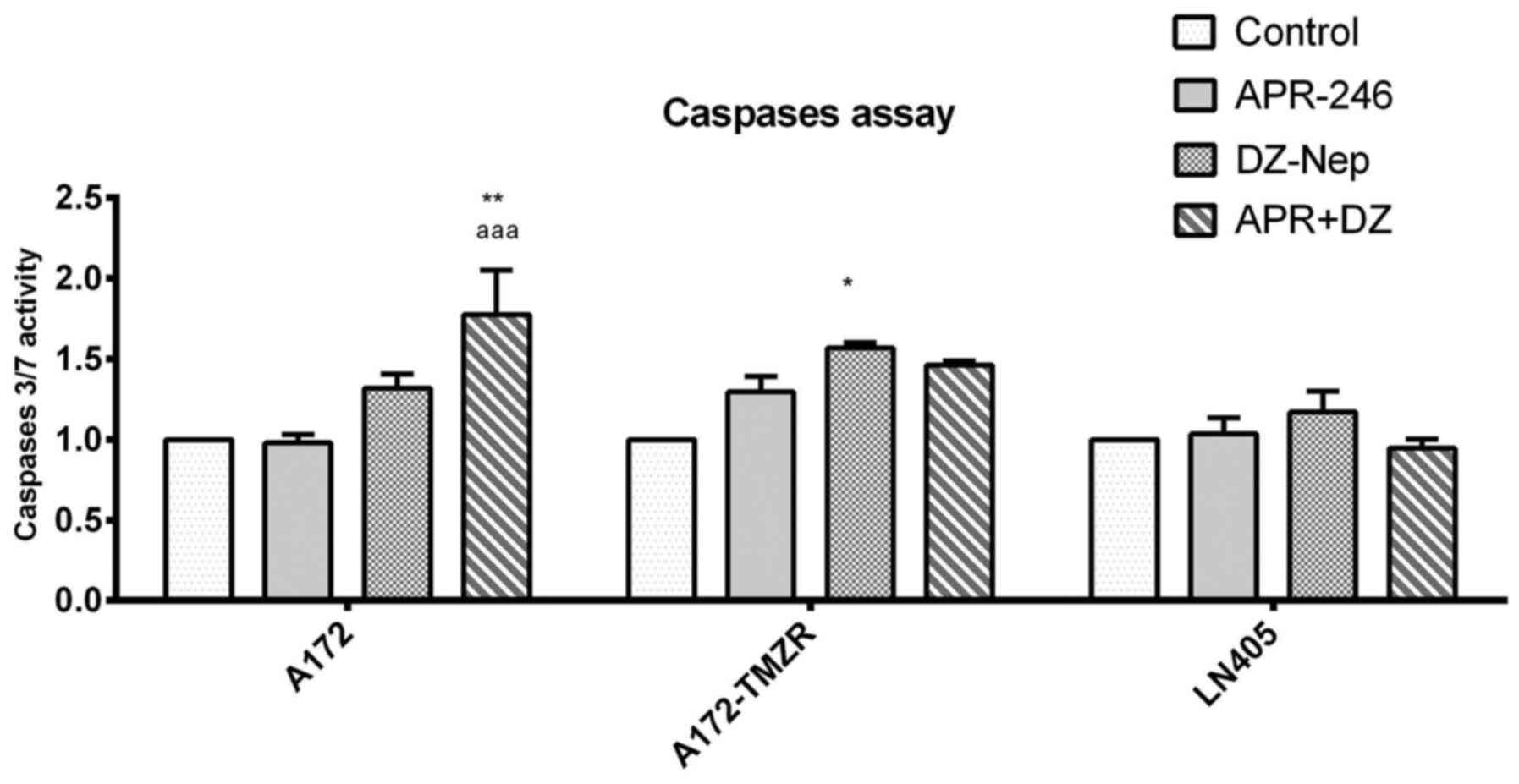 |
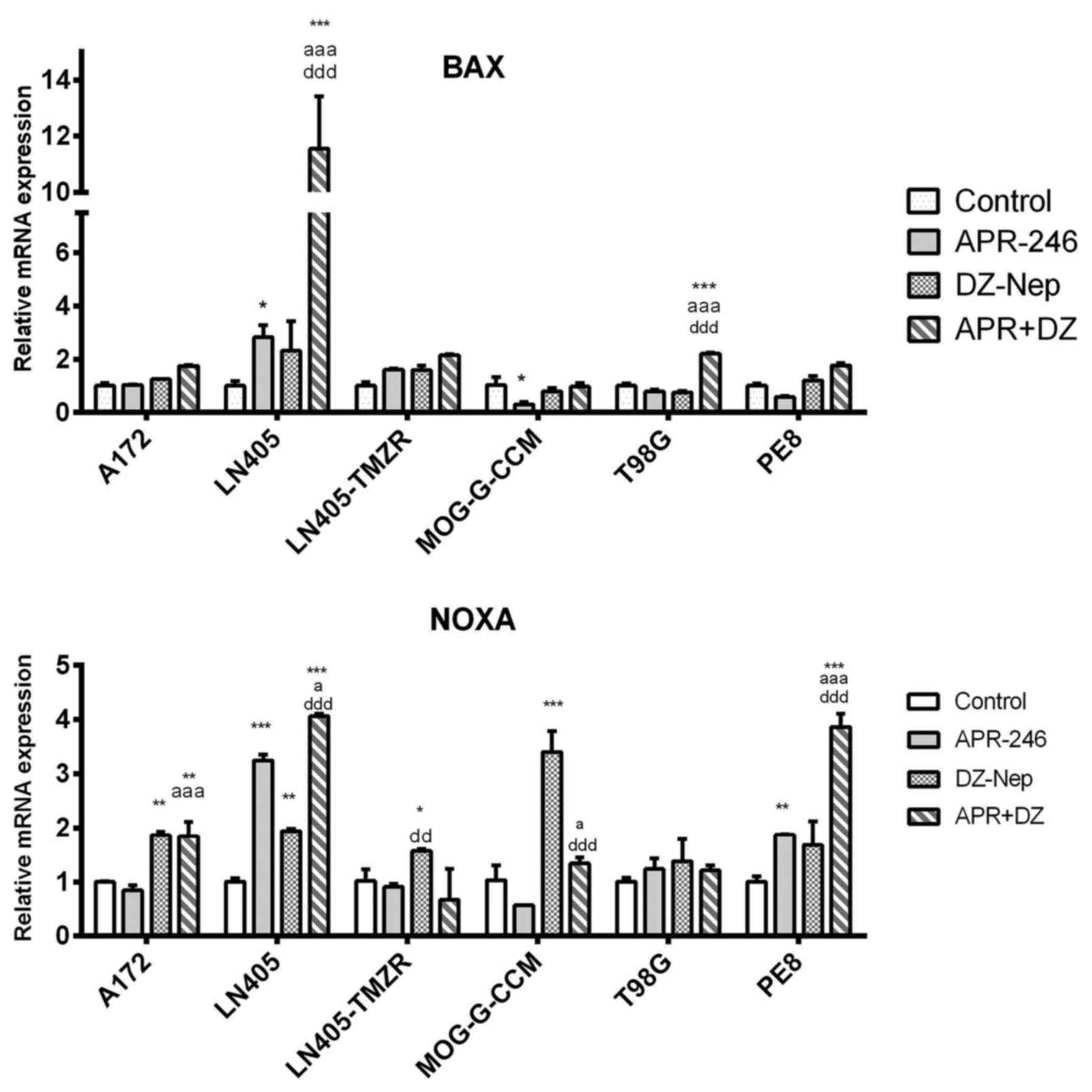 |
 |
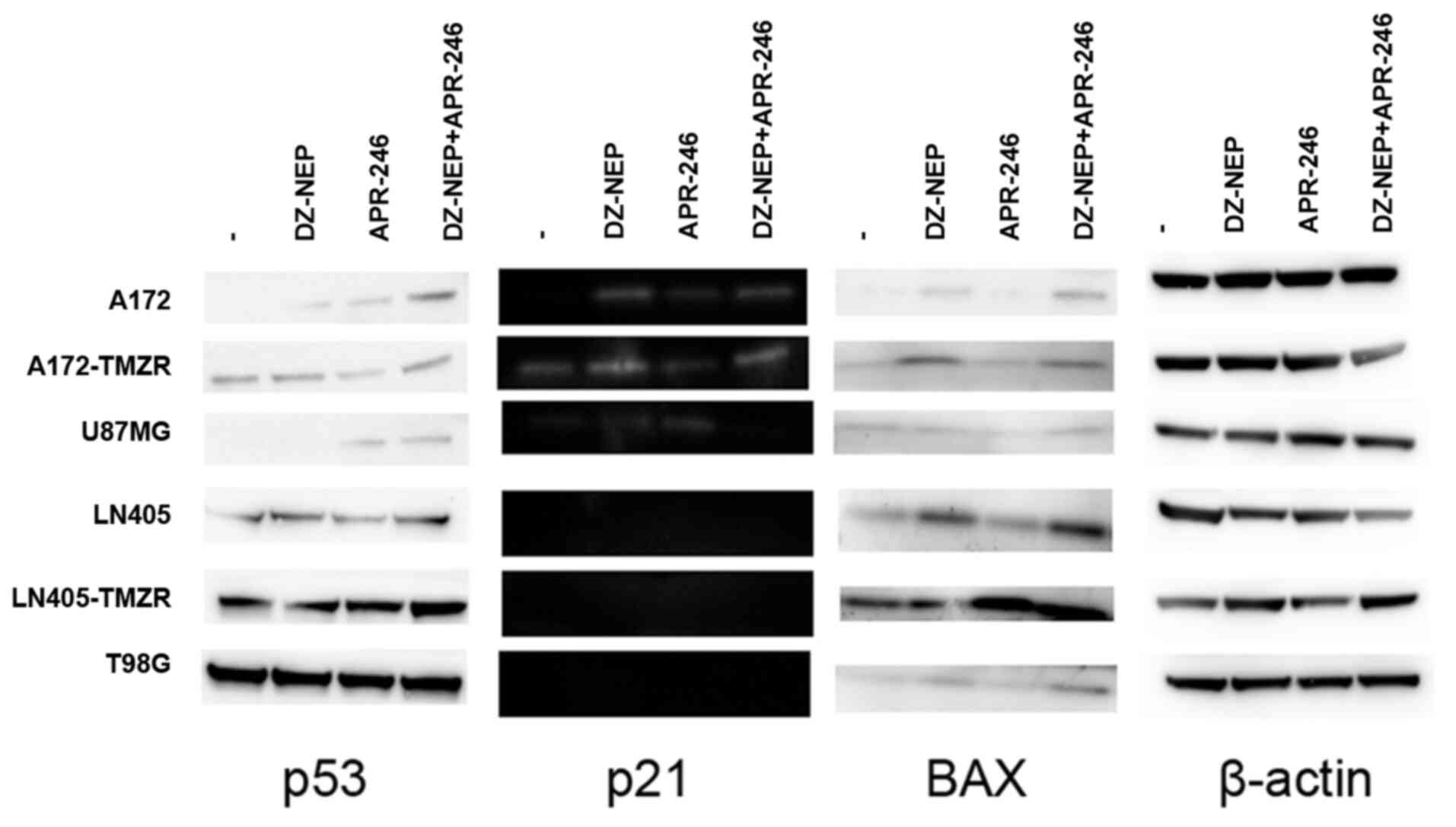 |
 |
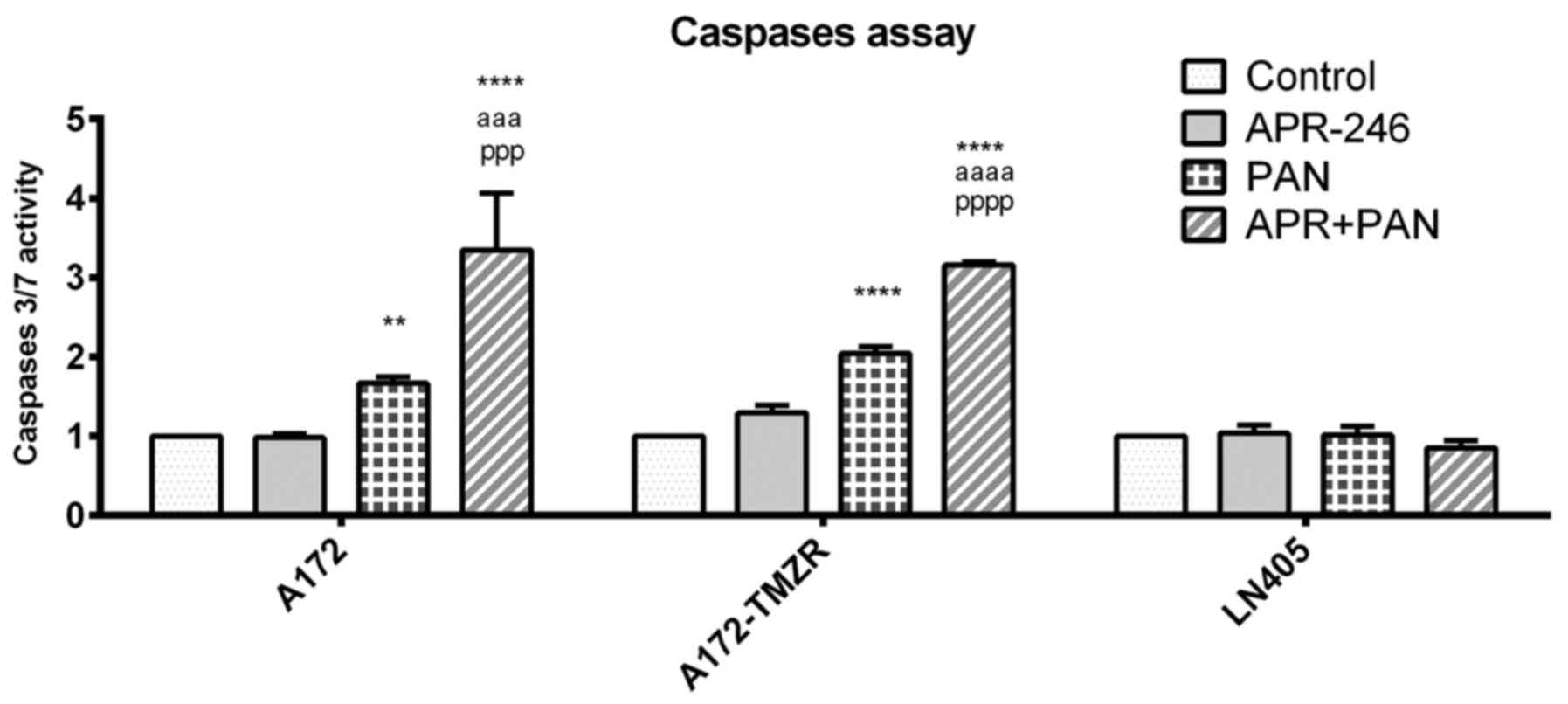 |
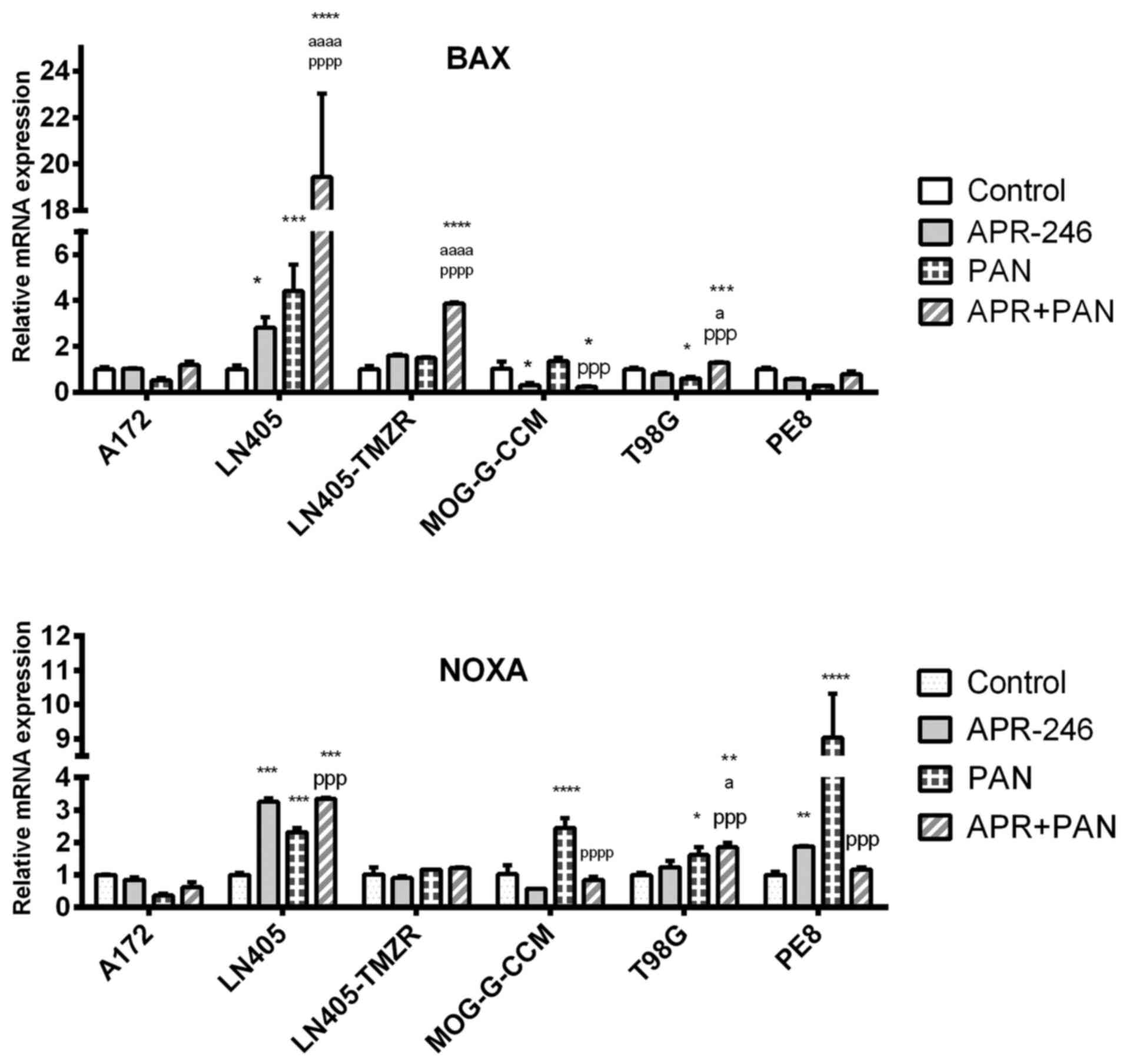 |
 |
 |
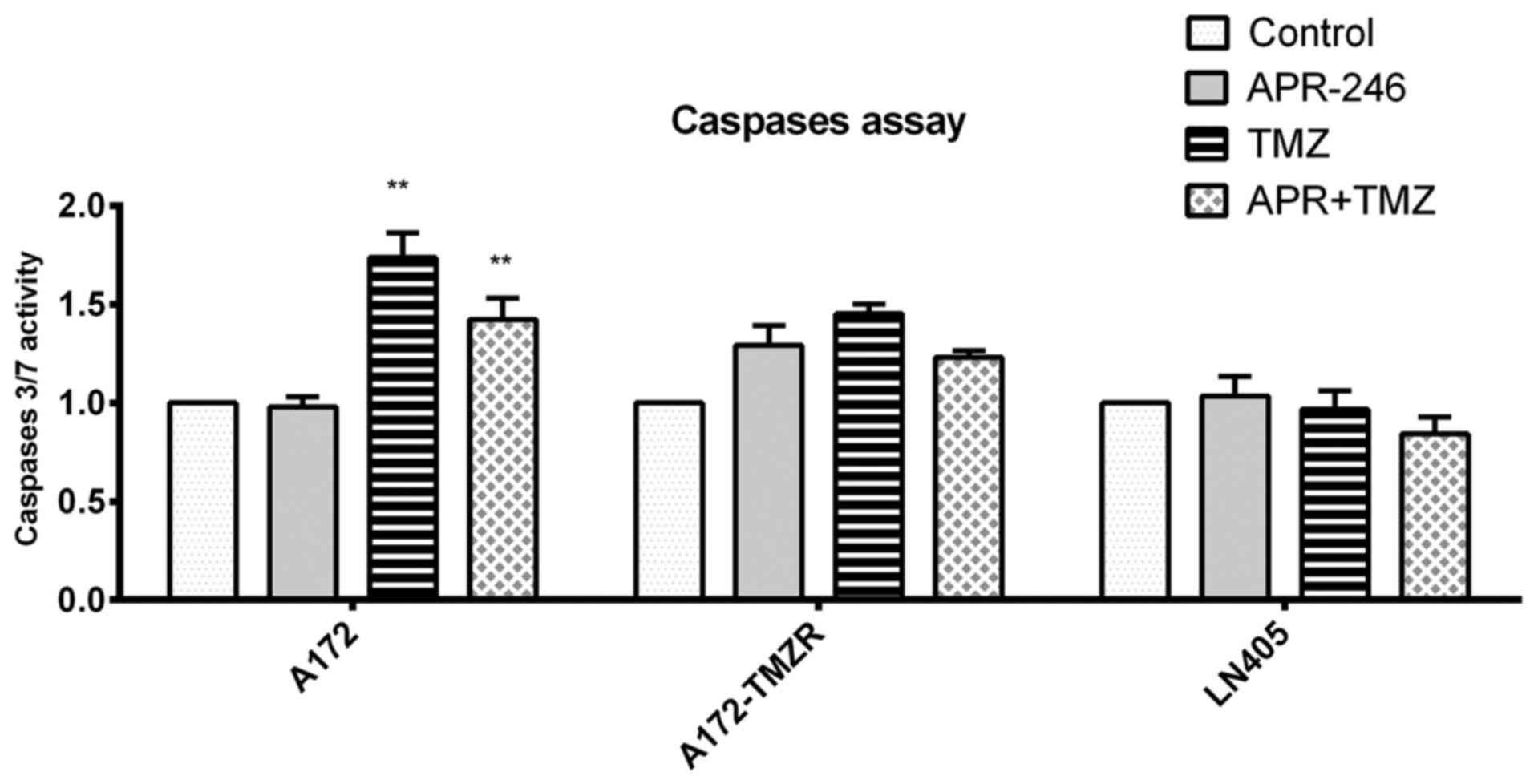 |
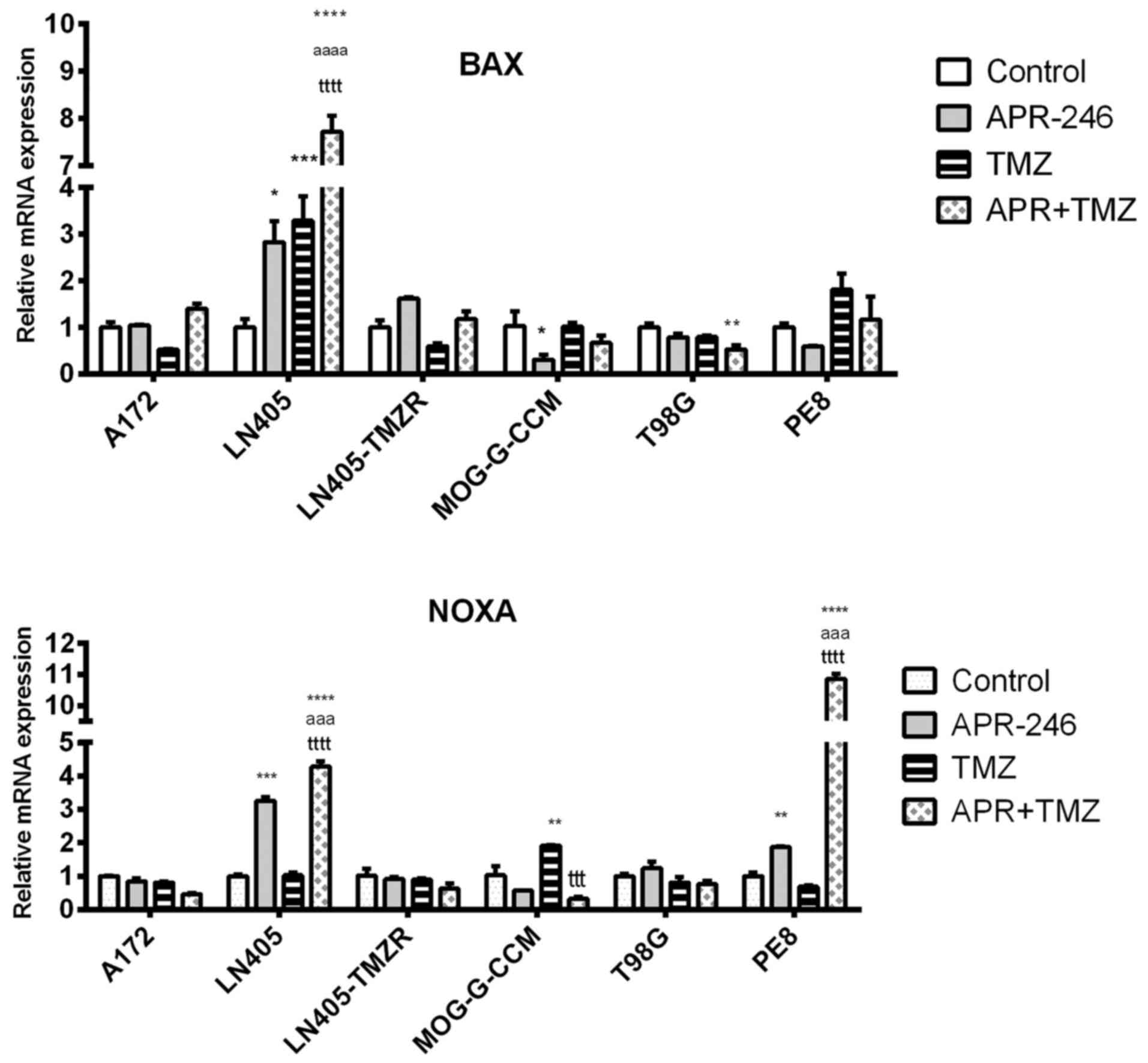 |
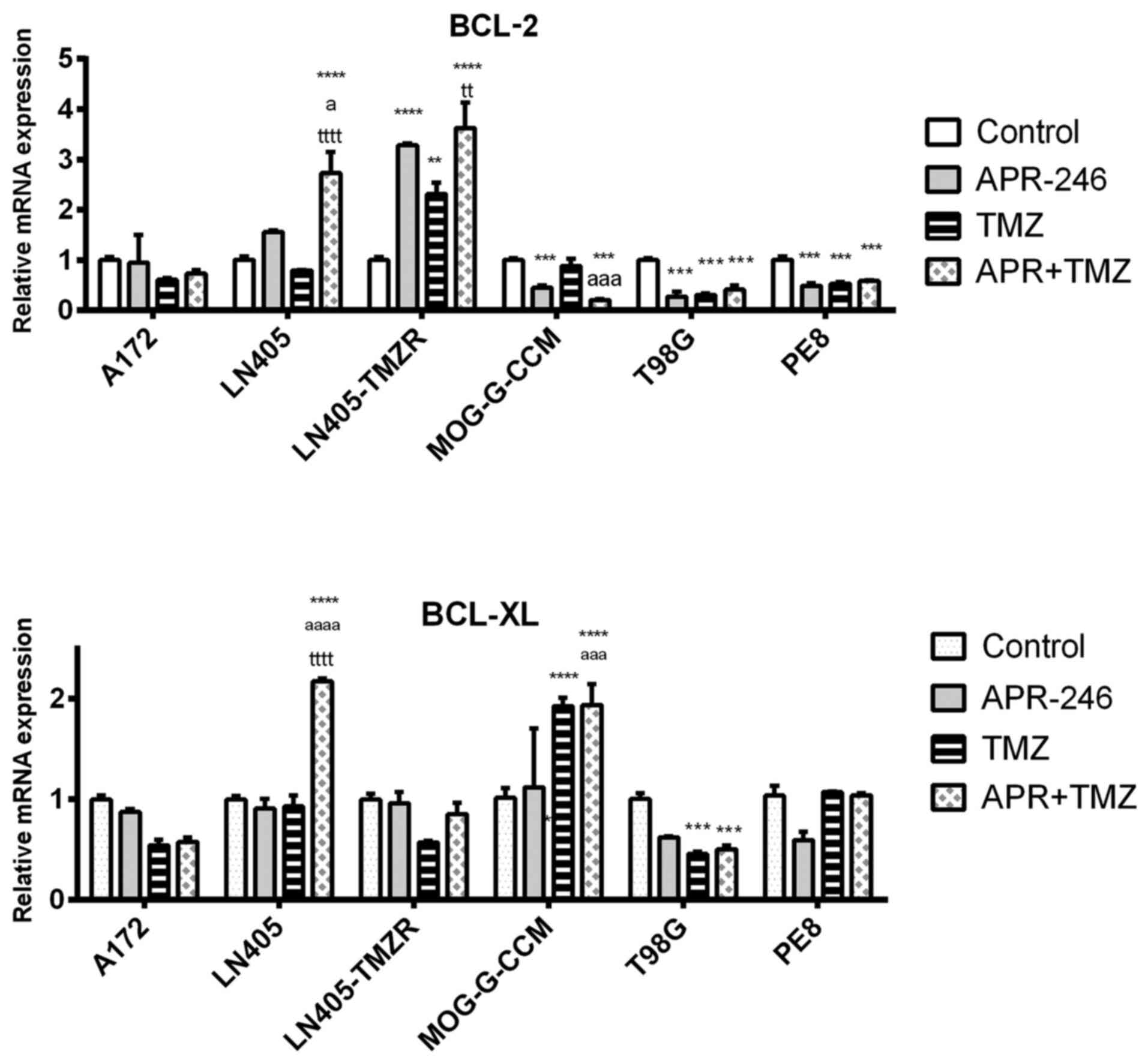 |
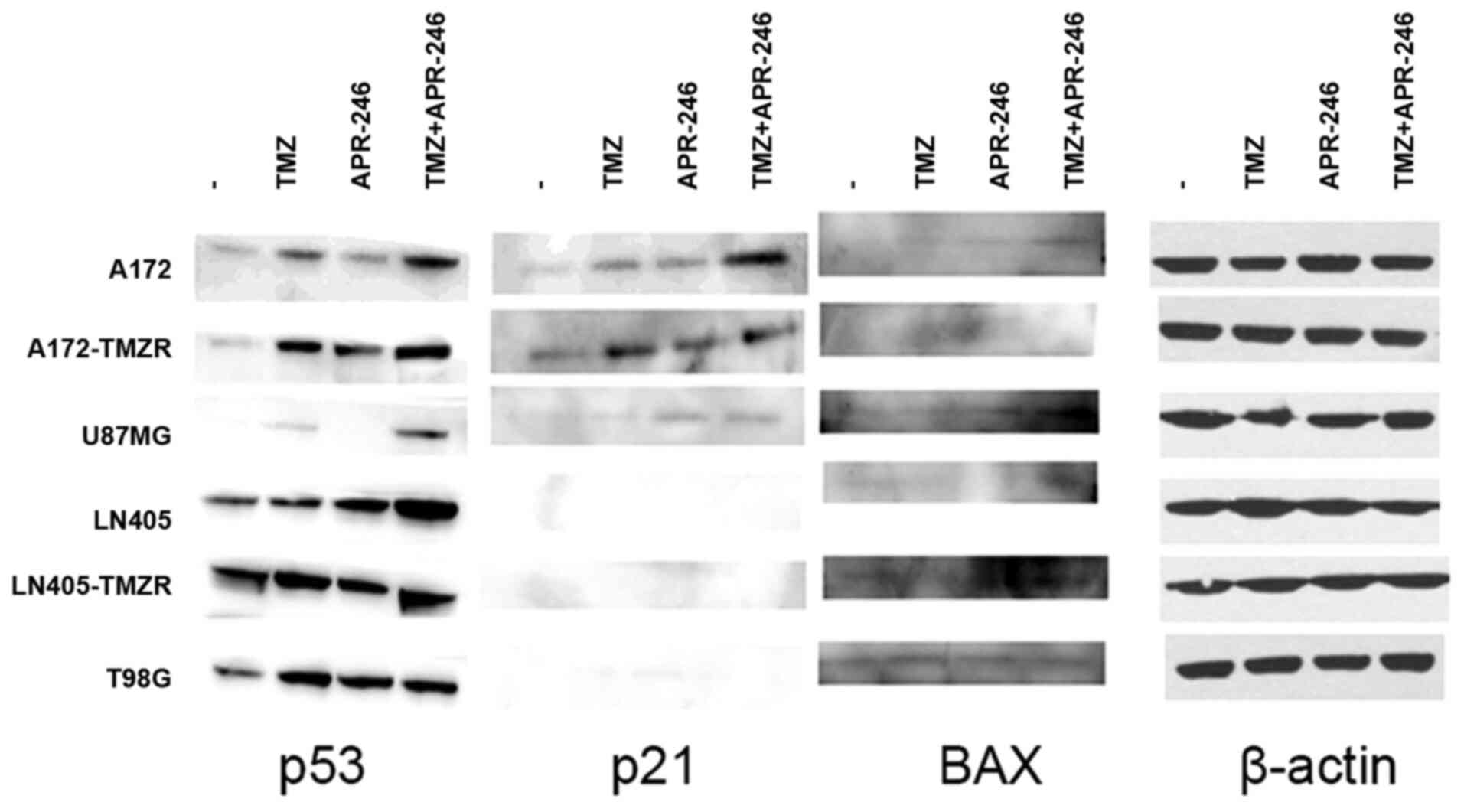 |
|
Wirsching HG, Galanis E and Weller M: Glioblastoma. Handb Clin Neurol. 134:381–397. 2016. View Article : Google Scholar : PubMed/NCBI | |
|
Louis DN, Perry A, Reifenberger G, von Deimling A, Figarella-Branger D, Cavenee WK, Ohgaki H, Wiestler OD, Kleihues P and Ellison DW: The 2016 World Health Organization Classification of Tumors of the Central Nervous System: A summary. Acta Neuropathol. 131:803–820. 2016. View Article : Google Scholar : PubMed/NCBI | |
|
De La Rosa J, Urdiciain A, Zazpe I, Zelaya MV, Meléndez B, Rey JA, Idoate MA and Castresana JS: The synergistic effect of DZ NEP, panobinostat and temozolomide reduces clonogenicity and induces apoptosis in glioblastoma cells. Int J Oncol. 56:283–300. 2020. | |
|
Urdiciain A, Erausquin E, Meléndez B, Rey JA, Idoate MA and Castresana JS: Tubastatin A, an inhibitor of HDAC6, enhances temozolomide induced apoptosis and reverses the malignant phenotype of glioblastoma cells. Int J Oncol. 54:1797–1808. 2019.PubMed/NCBI | |
|
Campomenosi P, Ottaggio L, Moro F, Urbini S, Bogliolo M, Zunino A, Camoriano A, Inga A, Gentile SL, Pellegata NS, et al: Study on aneuploidy and p53 mutations in astrocytomas. Cancer Genet Cytogenet. 88:95–102. 1996. View Article : Google Scholar : PubMed/NCBI | |
|
Pedrote MM, Motta MF, Ferretti GD, Norberto DR, Spohr TC, Lima FR, Gratton E, Silva JL and de Oliveira GA: Oncogenic gain of function in glioblastoma is linked to mutant p53 amyloid oligomers. iScience. 23:1008202020. View Article : Google Scholar : PubMed/NCBI | |
|
Shiraishi S, Tada K, Nakamura H, Makino K, Kochi M, Saya H, Kuratsu J and Ushio Y: Influence of p53 mutations on prognosis of patients with glioblastoma. Cancer. 95:249–257. 2002. View Article : Google Scholar : PubMed/NCBI | |
|
Bykov VJ and Wiman KG: Mutant p53 reactivation by small molecules makes its way to the clinic. FEBS Lett. 588:2622–2627. 2014. View Article : Google Scholar : PubMed/NCBI | |
|
Bykov VJ, Zhang Q, Zhang M, Ceder S, Abrahmsen L and Wiman KG: Targeting of mutant p53 and the cellular redox balance by APR-246 as a strategy for efficient cancer therapy. Front Oncol. 6:212016. View Article : Google Scholar : PubMed/NCBI | |
|
Lambert JM, Gorzov P, Veprintsev DB, Söderqvist M, Segerbäck D, Bergman J, Fersht AR, Hainaut P, Wiman KG and Bykov VJ: PRIMA-1 reactivates mutant p53 by covalent binding to the core domain. Cancer Cell. 15:376–388. 2009. View Article : Google Scholar : PubMed/NCBI | |
|
Levine AJ, Wu MC, Chang A, Silver A, Attiyeh EF, Lin J and Epstein CB: The spectrum of mutations at the p53 locus. Evidence for tissue-specific mutagenesis, selection of mutant alleles, and a 'gain of function' phenotype. Ann NY Acad Sci. 768:111–128. 1995. View Article : Google Scholar | |
|
Strano S, Dell'Orso S, Di Agostino S, Fontemaggi G, Sacchi A and Blandino G: Mutant p53: An oncogenic transcription factor. Oncogene. 26:2212–2219. 2007. View Article : Google Scholar : PubMed/NCBI | |
|
Soussi T and Wiman KG: TP53: An oncogene in disguise. Cell Death Differ. 22:1239–1249. 2015. View Article : Google Scholar : PubMed/NCBI | |
|
Brosh R and Rotter V: When mutants gain new powers: News from the mutant p53 field. Nat Rev Cancer. 9:701–713. 2009. View Article : Google Scholar : PubMed/NCBI | |
|
Oren M and Rotter V: Mutant p53 gain-of-function in cancer. Cold Spring Harb Perspect Biol. 2:a0011072010. View Article : Google Scholar : PubMed/NCBI | |
|
Chène P: The role of tetramerization in p53 function. Oncogene. 20:2611–2617. 2001. View Article : Google Scholar : PubMed/NCBI | |
|
Gencel-Augusto J and Lozano G: p53 tetramerization: At the center of the dominant-negative effect of mutant p53. Genes Dev. 34:1128–1146. 2020. View Article : Google Scholar : PubMed/NCBI | |
|
Pitolli C, Wang Y, Mancini M, Shi Y, Melino G and Amelio I: Do mutations turn p53 into an oncogene? Int J Mol Sci. 20:202019. View Article : Google Scholar | |
|
Doyle B, Morton JP, Delaney DW, Ridgway RA, Wilkins JA and Sansom OJ: p53 mutation and loss have different effects on tumourigenesis in a novel mouse model of pleomorphic rhabdo-myosarcoma. J Pathol. 222:129–137. 2010. View Article : Google Scholar : PubMed/NCBI | |
|
Wang X, Chen JX, Liu JP, You C, Liu YH and Mao Q: Gain of function of mutant TP53 in glioblastoma: Prognosis and response to temozolomide. Ann Surg Oncol. 21:1337–1344. 2014. View Article : Google Scholar | |
|
Wang X, Chen JX, Liu YH, You C and Mao Q: Mutant TP53 enhances the resistance of glioblastoma cells to temozolomide by up-regulating O(6)-methylguanine DNA-methyltransferase. Neurol Sci. 34:1421–1428. 2013. View Article : Google Scholar | |
|
Petitjean A, Achatz MI, Borresen-Dale AL, Hainaut P and Olivier M: TP53 mutations in human cancers: Functional selection and impact on cancer prognosis and outcomes. Oncogene. 26:2157–2165. 2007. View Article : Google Scholar : PubMed/NCBI | |
|
Langerød A, Zhao H, Borgan Ø, Nesland JM, Bukholm IR, Ikdahl T, Kåresen R, Børresen-Dale AL and Jeffrey SS: TP53 mutation status and gene expression profiles are powerful prognostic markers of breast cancer. Breast Cancer Res. 9:R302007. View Article : Google Scholar : PubMed/NCBI | |
|
Leroy B, Fournier JL, Ishioka C, Monti P, Inga A, Fronza G and Soussi T: The TP53 website: An integrative resource centre for the TP53 mutation database and TP53 mutant analysis. Nucleic Acids Res. 41:D962–D969. 2013. View Article : Google Scholar : | |
|
Dumay A, Feugeas JP, Wittmer E, Lehmann-Che J, Bertheau P, Espié M, Plassa LF, Cottu P, Marty M, André F, et al: Distinct tumor protein p53 mutants in breast cancer subgroups. Int J Cancer. 132:1227–1231. 2013. View Article : Google Scholar | |
|
Lehmann S, Bykov VJ, Ali D, Andrén O, Cherif H, Tidefelt U, Uggla B, Yachnin J, Juliusson G, Moshfegh A, et al: Targeting p53 in vivo: A first-in-human study with p53-targeting compound APR-246 in refractory hematologic malignancies and prostate cancer. J Clin Oncol. 30:3633–3639. 2012. View Article : Google Scholar : PubMed/NCBI | |
|
Omar SI and Tuszynski J: The molecular mechanism of action of methylene quinuclidinone and its effects on the structure of p53 mutants. Oncotarget. 9:37137–37156. 2018. View Article : Google Scholar | |
|
Weinmann L, Wischhusen J, Demma MJ, Naumann U, Roth P, Dasmahapatra B and Weller M: A novel p53 rescue compound induces p53-dependent growth arrest and sensitises glioma cells to Apo2L/TRAIL-induced apoptosis. Cell Death Differ. 15:718–729. 2008. View Article : Google Scholar : PubMed/NCBI | |
|
Patyka M, Sharifi Z, Petrecca K, Mansure J, Jean-Claude B and Sabri S: Sensitivity to PRIMA-1MET is associated with decreased MGMT in human glioblastoma cells and glioblastoma stem cells irrespective of p53 status. Oncotarget. 7:60245–60269. 2016. View Article : Google Scholar : PubMed/NCBI | |
|
Momparler RL and Côté S: Targeting of cancer stem cells by inhibitors of DNA and histone methylation. Expert Opin Investig Drugs. 24:1031–1043. 2015. View Article : Google Scholar : PubMed/NCBI | |
|
Srinivas NR: Clinical pharmacokinetics of panobinostat, a novel histone deacetylase (HDAC) inhibitor: Review and perspectives. Xenobiotica. 47:354–368. 2017. View Article : Google Scholar | |
|
Chou TC: Drug combination studies and their synergy quantification using the Chou-Talalay method. Cancer Res. 70:440–446. 2010. View Article : Google Scholar : PubMed/NCBI | |
|
Chou T and Martin N: CompuSyn Software for Drug Combinations and for General Dose Effect Analysis, and user's guide. ComboSyn, Inc; Paramus, NJ: 2005 | |
|
Dulić V, Kaufmann WK, Wilson SJ, Tlsty TD, Lees E, Harper JW, Elledge SJ and Reed SI: p53-dependent inhibition of cyclin-dependent kinase activities in human fibroblasts during radiation-induced G1 arrest. Cell. 76:1013–1023. 1994. View Article : Google Scholar | |
|
Liu X, Shi Y, Guan R, Donawho C, Luo Y, Palma J, Zhu GD, Johnson EF, Rodriguez LE, Ghoreishi-Haack N, et al: Potentiation of temozolomide cytotoxicity by poly(ADP)ribose polymerase inhibitor ABT-888 requires a conversion of single-stranded DNA damages to double-stranded DNA breaks. Mol Cancer Res. 6:1621–1629. 2008. View Article : Google Scholar : PubMed/NCBI | |
|
Stupp R, Mason WP, van den Bent MJ, Weller M, Fisher B, Taphoorn MJ, Belanger K, Brandes AA, Marosi C, Bogdahn U, et al European Organisation for Research and Treatment of Cancer Brain Tumor and Radiotherapy Groups; National Cancer Institute of Canada Clinical Trials Group: Radiotherapy plus concomitant and adjuvant temozolomide for glioblastoma. N Engl J Med. 352:987–996. 2005. View Article : Google Scholar : PubMed/NCBI | |
|
Komotar RJ, Otten ML, Moise G and Connolly ES Jr: Radiotherapy plus concomitant and adjuvant temozolomide for glioblastoma-a critical review. Clin Med Oncol. 2:421–422. 2008.PubMed/NCBI | |
|
Maslah N, Salomao N, Drevon L, Verger E, Partouche N, Ly P, Aubin P, Naoui N, Schlageter MH, Bally C, et al: Synergistic effects of PRIMA-1Met (APR-246) and 5-azacitidine in TP53-mutated myelodysplastic syndromes and acute myeloid leukemia. Haematologica. 105:1539–1551. 2020. View Article : Google Scholar : | |
|
Fransson Å, Glaessgen D, Alfredsson J, Wiman KG, Bajalica-Lagercrantz S and Mohell N: Strong synergy with APR-246 and DNA-damaging drugs in primary cancer cells from patients with TP53 mutant High-Grade Serous ovarian cancer. J Ovarian Res. 9:272016. View Article : Google Scholar : PubMed/NCBI | |
|
Peng X, Zhang MQ, Conserva F, Hosny G, Selivanova G, Bykov VJ, Arnér ES and Wiman KG: APR-246/PRIMA-1MET inhibits thioredoxin reductase 1 and converts the enzyme to a dedicated NADPH oxidase. Cell Death Dis. 4:e8812013. View Article : Google Scholar : PubMed/NCBI | |
|
Aryee DN, Niedan S, Ban J, Schwentner R, Muehlbacher K, Kauer M, Kofler R and Kovar H: Variability in functional p53 reactivation by PRIMA-1(Met)/APR-246 in Ewing sarcoma. Br J Cancer. 109:2696–2704. 2013. View Article : Google Scholar : PubMed/NCBI | |
|
Robles AI, Jen J and Harris CC: Clinical outcomes of TP53 mutations in cancers. Cold Spring Harb Perspect Med. 6:a0262942016. View Article : Google Scholar : PubMed/NCBI | |
|
Walerych D, Lisek K and Del Sal G: Mutant p53: One, no one, and one hundred thousand. Front Oncol. 5:2892015. View Article : Google Scholar | |
|
Pflaum J, Schlosser S and Müller M: p53 Family and cellular stress responses in cancer. Front Oncol. 4:2852014. View Article : Google Scholar : PubMed/NCBI | |
|
Osanai T, Takagi Y, Toriya Y, Nakagawa T, Aruga T, Iida S, Uetake H and Sugihara K: Inverse correlation between the expression of O6-methylguanine-DNA methyl transferase (MGMT) and p53 in breast cancer. Jpn J Clin Oncol. 35:121–125. 2005. View Article : Google Scholar : PubMed/NCBI | |
|
Cabrini G, Fabbri E, Lo Nigro C, Dechecchi MC and Gambari R: Regulation of expression of O6-methylguanine-DNA methyl-transferase and the treatment of glioblastoma (Review). Int J Oncol. 47:417–428. 2015. View Article : Google Scholar : PubMed/NCBI | |
|
Oldrini B, Vaquero-Siguero N, Mu Q, Kroon P, Zhang Y, Galán-Ganga M, Bao Z, Wang Z, Liu H, Sa JK, et al: MGMT genomic rearrangements contribute to chemotherapy resistance in gliomas. Nat Commun. 11:38832020. View Article : Google Scholar : PubMed/NCBI | |
|
Barciszewska AM, Gurda D, Głodowicz P, Nowak S and Naskręt-Barciszewska MZ: A new epigenetic mechanism of temozolomide action in glioma cells. PLoS One. 10:e01366692015. View Article : Google Scholar : PubMed/NCBI | |
|
Lo Dico A, Salvatore D, Martelli C, Ronchi D, Diceglie C, Lucignani G and Ottobrini L: Intracellular redox-balance involvement in temozolomide resistance-related molecular mechanisms in glioblastoma. Cells. 8:82019. | |
|
Rabé M, Dumont S, Álvarez-Arenas A, Janati H, Belmonte-Beitia J, Calvo GF, Thibault-Carpentier C, Séry Q, Chauvin C, Joalland N, et al: Identification of a transient state during the acquisition of temozolomide resistance in glioblastoma. Cell Death Dis. 11:192020. View Article : Google Scholar : PubMed/NCBI | |
|
Cheng LL, Itahana Y, Lei ZD, Chia NY, Wu Y, Yu Y, Zhang SL, Thike AA, Pandey A, Rozen S, et al: TP53 genomic status regulates sensitivity of gastric cancer cells to the histone meth-ylation inhibitor 3-deazaneplanocin A (DZNep). Clin Cancer Res. 18:4201–4212. 2012. View Article : Google Scholar : PubMed/NCBI | |
|
Cui B, Yang Q, Guan H, Shi B, Hou P and Ji M: PRIMA-1, a mutant p53 reactivator, restores the sensitivity of TP53 mutant-type thyroid cancer cells to the histone methylation inhibitor 3-Deazaneplanocin A. J Clin Endocrinol Metab. 99:E962–E970. 2014. View Article : Google Scholar : PubMed/NCBI | |
|
Zhou J, Bi C, Cheong LL, Mahara S, Liu SC, Tay KG, Koh TL, Yu Q and Chng WJ: The histone methyltransferase inhibitor, DZNep, up-regulates TXNIP, increases ROS production, and targets leukemia cells in AML. Blood. 118:2830–2839. 2011. View Article : Google Scholar : PubMed/NCBI | |
|
Juan LJ, Shia WJ, Chen MH, Yang WM, Seto E, Lin YS and Wu CW: Histone deacetylases specifically down-regulate p53-dependent gene activation. J Biol Chem. 275:20436–20443. 2000. View Article : Google Scholar : PubMed/NCBI | |
|
Cai Y, Yan X, Zhang G, Zhao W and Jiao S: The predictive value of ERCC1 and p53 for the effect of panobinostat and cisplatin combination treatment in NSCLC. Oncotarget. 6:18997–19005. 2015. View Article : Google Scholar : PubMed/NCBI | |
|
Greve G, Schiffmann I, Pfeifer D, Pantic M, Schüler J and Lübbert M: The pan-HDAC inhibitor panobinostat acts as a sensitizer for erlotinib activity in EGFR-mutated and -wildtype non-small cell lung cancer cells. BMC Cancer. 15:9472015. View Article : Google Scholar : PubMed/NCBI | |
|
Chan D, Zheng Y, Tyner JW, Chng WJ, Chien WW, Gery S, Leong G, Braunstein GD and Koeffler HP: Belinostat and pano-binostat (HDACI): In vitro and in vivo studies in thyroid cancer. J Cancer Res Clin Oncol. 139:1507–1514. 2013. View Article : Google Scholar : PubMed/NCBI | |
|
Andreu-Vieyra CV and Berenson JR: The potential of panobinostat as a treatment option in patients with relapsed and refractory multiple myeloma. Ther Adv Hematol. 5:197–210. 2014. View Article : Google Scholar : PubMed/NCBI | |
|
Anne M, Sammartino D, Barginear MF and Budman D: Profile of panobinostat and its potential for treatment in solid tumors: An update. OncoTargets Ther. 6:1613–1624. 2013. View Article : Google Scholar | |
|
Gao L, Gao M, Yang G, Tao Y, Kong Y, Yang R, Meng X, Ai G, Wei R, Wu H, et al: Synergistic activity of carfilzomib and panobinostat in multiple myeloma cells via modulation of ROS generation and ERK1/2. BioMed Res Int. 2015:4590522015. View Article : Google Scholar : PubMed/NCBI | |
|
Yung WK: Temozolomide in malignant gliomas. Semin Oncol. 27(Suppl 6): 27–34. 2000.PubMed/NCBI | |
|
Johannessen TC and Bjerkvig R: Molecular mechanisms of temozolomide resistance in glioblastoma multiforme. Expert Rev Anticancer Ther. 12:635–642. 2012. View Article : Google Scholar : PubMed/NCBI | |
|
Grogan PT, Sarkaria JN, Timmermann BN and Cohen MS: Oxidative cytotoxic agent withaferin A resensitizes temo-zolomide-resistant glioblastomas via MGMT depletion and induces apoptosis through Akt/mTOR pathway inhibitory modulation. Invest New Drugs. 32:604–617. 2014. View Article : Google Scholar : PubMed/NCBI | |
|
Günther W, Pawlak E, Damasceno R, Arnold H and Terzis AJ: Temozolomide induces apoptosis and senescence in glioma cells cultured as multicellular spheroids. Br J Cancer. 88:463–469. 2003. View Article : Google Scholar : PubMed/NCBI | |
|
Kohsaka S, Takahashi K, Wang L, Tanino M, Kimura T, Nishihara H and Tanaka S: Inhibition of GSH synthesis potentiates temozolomide-induced bystander effect in glioblastoma. Cancer Lett. 331:68–75. 2013. View Article : Google Scholar | |
|
Haffo L, Lu J, Bykov VJ, Martin SS, Ren X, Coppo L, Wiman KG and Holmgren A: Inhibition of the glutaredoxin and thioredoxin systems and ribonucleotide reductase by mutant p53-targeting compound APR-246. Sci Rep. 8:126712018. View Article : Google Scholar : PubMed/NCBI |









